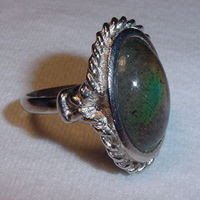 A
mood ring is a novelty ring which changes color in response to body
temperature, using a thermochromic liquid crystal. The mood ring is a
form of biofeedback and supposedly indicates the temperament of the
wearer, indicated by the ring's color. Mood rings were a fad whose
popularity peaked in the United States in the 1970s, and they are now
seen as an icon of 1970s culture.
A
mood ring is a novelty ring which changes color in response to body
temperature, using a thermochromic liquid crystal. The mood ring is a
form of biofeedback and supposedly indicates the temperament of the
wearer, indicated by the ring's color. Mood rings were a fad whose
popularity peaked in the United States in the 1970s, and they are now
seen as an icon of 1970s culture.
There are many different types of mood rings, and it generally depends
on the manufacturer which mood the colors represent. The ring has
however, also appeared as other forms of jewelery including in
necklaces, earrings, and toerings. In present day, the finger rings and
the earrings are the most popular.
Wernick encapsulated ovals of the material within clear glass cameos and
glass domes set in brushed gold and silver ring settings. His signature
"hang-tag" explained the ring's amazing properties. (Pictures are not
original Mood Rings, but independent manufacturers using the concept.)

Joshua Reynolds reportedly invented the Thighmaster, and was the heir to
the Richard Joshua Reynolds tobacco fortune. Reynolds envisioned the
mood rings as "portable biofeedback aids", and managed to sell $1
million worth of them in a three month period in 1975. Even so,
Reynold's company went bankrupt, victim of a flooded market of
imitations.

Due to fluctuations in the making of mood rings by various companies,
interpretation of mood ring colors are not universal. However, a certain
standard is fairly  prevalent,
and is the only one commonly found in any form of documentation. This
standard is based on the crystals being calibrated to have the color
green reflected at 82 degrees Fahrenheit (27.7 degrees Celsius), which
is the typical surface temperature of people. Variations of the actual
"neutral temperature", caused by differing surface temperatures among
different people, as well as effects from outside temperatures, cause
mood ring measurements to differ, and make their readouts rather
unreliable.
prevalent,
and is the only one commonly found in any form of documentation. This
standard is based on the crystals being calibrated to have the color
green reflected at 82 degrees Fahrenheit (27.7 degrees Celsius), which
is the typical surface temperature of people. Variations of the actual
"neutral temperature", caused by differing surface temperatures among
different people, as well as effects from outside temperatures, cause
mood ring measurements to differ, and make their readouts rather
unreliable.

Grey: Anxious, nervous, strained
Amber: Nervous, emotions mixed, unsettled
Green: Average reading. Active, not under great stress
Blue-green: Emotionally charged, somewhat relaxed
Blue: Relaxed, at ease, calm
Dark blue/Purple: happy, romantic, passion

 to move closer to the surface, raising surface temperature. This is
rendered in the mood ring by the color moving toward blue-green, blue,
and then a darkened blue.
to move closer to the surface, raising surface temperature. This is
rendered in the mood ring by the color moving toward blue-green, blue,
and then a darkened blue.
A mood ring plays a key part in the 1991 movie My Girl, and the actors that were in the movie now wear mood rings.
"Mood Ring" is a song by Paul Thorn from his 1999 album "Ain't Love Strange"
"Mood Rings" is a song by Relient K about emotional girls and their unpredictability.
Rhythm and blues singer Mýa named her third CD Moodring because she felt that each song represented a different color.
Skate-Gate, an episode of The Replacements, reveals that Dick Daring, Riley and Todd's father, wears a mood ring.
The episode of the TV series "Aladdin" titled "The Flawed Couple"
features a villain that uses jewels known as "Mood Stones" which
actually change the mood of the person wearing it.
*From Wikipedia, the free encyclopedia

No comments:
Post a Comment
Contact The Wizard!
(he/him)